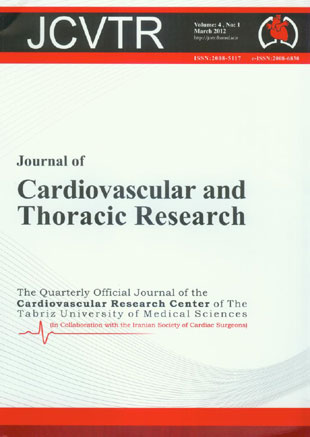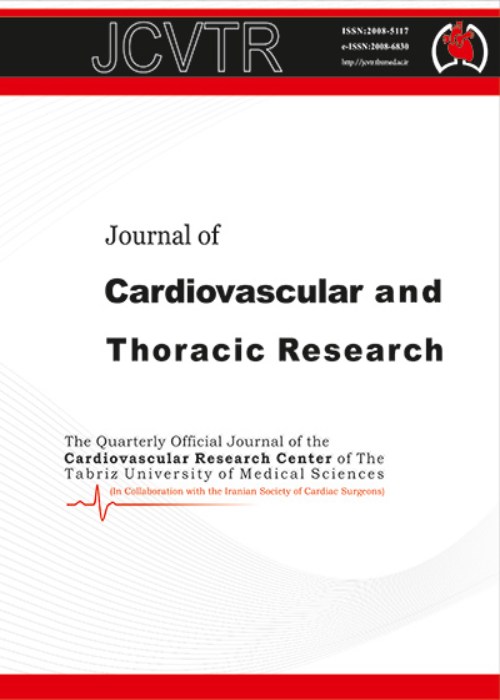فهرست مطالب

Journal of Cardiovascular and Thoracic Research
Volume:4 Issue: 1, Feb 2012
- تاریخ انتشار: 1391/05/17
- تعداد عناوین: 7
-
-
Pages 1-4IntroductionOxidation of low-density lipoprotein (LDL) is believed to be a key factor in the development of atherosclerosis. Oxidative modification of LDL is associated with in-creased uptake of these particles by the macrophage receptors located in the arterial wall which in turns would lead to accumulation of lipids within the cytoplasm of the cell and formation of the foam cells, a perquisite step in the development of the atherosclerotic pla-que. The aim of the present study was to evaluate the association between serum Ferritin and oxidized low-density lipoprotein in coronary artery disease (CAD) patients.MethodsThe study group consisted of 160 males [mean age (47±7) years] with suspected CAD and no history of renal, liver and diabetic disorders undergoing coronary angiography. Oxi-dized LDL and Ferritin levels were measured by ELISA methods.ResultsResults ob-tained from the study revealed that the mean serum Ferritin concentration in our study population was 149.77+119.93 ng/ml and that of OX-LDL was 8.86+5.67 IU/L. Serum Ferritin levels were significantly correlated with both OX-LDL concentrations (p=0.001, r=0.24) and CAD SCORE (p=0.005, r=0.208) in study patients group; however no correla-tion was detected between OX-LDL and CAD SCORE (p>0.9).ConclusionThe present study is the first to report serum Ferritin levels is associated with circulating OX-LDL lev-el in patients with CAD. The correlation of CAD SCORE with Ferritin levels in these pa-tients is indicative of the importance of this parameter in predicating CAD. These results suggest that measurement of OX- LDL and Ferritin could be of great assistance in predi-cating premature CHD.Keywords: Ferritin Oxidized Low, density Lipoprotein Coronary Artery Disease
-
Pages 5-9IntroductionBreast Cancer is the most common cancer in Iranian women and Iranian patients are relatively young. Given that Iran has a female population of about 38 million, this corresponds to a total number of 6000 new cases of breast cancer annually. This study aims to demonstrate the characteristics of breast cancers according to pathologic records in East Azerbaijan province, Iran.MethodsIn this retrospective cross-sectional study, 159314 pathology records of the main hospitals and pathology laboratories were observed for a period of 5 years. For each patient, sex, age, breast specimen pathology, pathological grading of malignant lesions and place of residence of patients were collected and statistically analyzed.ResultsThere were 12083 cancer cases; 902 of which were primary breast cancer. Breast cancer was the most common cancer in females (22.2%) but it ranks the 22nd in males. The annual incidence of breast cancer in women was 52.3 per 100,000. The mean age of women with breast cancer was 48.3±12.7 years (range, 16-85) and for male 54.0±13.6 years (range, 23-76). The highest frequency of malignancies was observed in the 40-49 year old age groups (34.5%). Invasive ductal carcinoma was the most common histological type diagnosed in both sexes.ConclusionIn Iran, breast cancer affects women at least one decade younger than developed countries. In spite of the rare incidence of breast cancer in men, the descriptive epidemiology of this malignancy is surprisingly similar to that of women. A considerable proportion of cancers of our research were in breast which mandates a national cancer detection program encouraging women for breast self-examination and participation in screening tests to improve breast cancer care.Keywords: Breast Cancer Incidence Iran
-
Pages 11-15IntroductionIn the current study, we evaluated the effect of anthropometric indices on ejection fraction following first acute anterior myocardial infarction.MethodsIn an analytic- cross sectional study, 50 patients with acute anterior myocardial infarction and abnormal anthropometric indices (Body Mass Index (BMI) ≥ 30, Waist Hip Ratio (WHR) ≥ 1 and ≥ 0.85 in males and females respectively and Waist Circumference (WC) ≥ 102 cm and ≥ 88 cm in males and females respectively) were recruited as case group and 50 patients with acute anterior myocardial infarction and normal anthropometric indices as control group. Subsequently, the relation between anthropometric indices and left ventricle dysfunction was evaluated and compared between two groups.Results77 people of the studied patients were male and 23 female with the mean age of 59± 1.2 years and an age range of 32-90 years. To evaluate the left ventricle function, the mean ejection fraction of the patients was measured as 34.3± 7.2 % and 44.8± 6.3% in patients with abnormal anthropometric indices and patients with normal anthropometric indices respectively (P= 0.0001). Calculation of the correlation coefficient between ejection fraction and BMI, WHR and WC in males and females revealed a moderate reverse (r=-0.521 to r=-0.691) and statistically significant (P= 0.0001) relations which was of more strength in females.ConclusionAnthropometric indices including BMI and waist circumference influence cardiac function following myocardial infarction.Keywords: Acute Myocardial Infarction Systolic Cardiac Function Anthropometric Indices Body Mass Index Waist Hip Ratio
-
Pages 17-20IntroductionPostoperative atrial fibrillation occurs in 20 % to 40 % of patients undergoing coronary artery bypass grafting (CABG) and contributes to increasing length of stay and hospital cost. The purpose of our study was to compare the length of hospital stay between patients of postoperative atrial fibrillation treated with amiodarone (experimental) and those with normal sinus rhythm (NSR) (Control) after CABG.MethodsFrom October of 2008 to October 2010, our experimental group including 26 patients was treated with amiodarone in Tabriz Madani Heart Center. The background variables, length of atrial fibrillation, and length of hospital stay were recorded. The experimental group was compared with a control group of 50 patients. The two groups were the same in terms of age, gender, ejection fraction, vascular diseases and risk factors.ResultsThe hospital stay duration was 8.0 ±1.6 and 7.4 ±1.4 days (p = 0.08) for experimental, and control groups respectively. Atrial fibrillation occurred mainly (60%) on the second postoperative day.Conclusion25 patients out of 26 patients (96 %) returned to NSR after starting the amiodarone protocol and the length of hospital stay in the experimental group was not significantly different from that of the control group. Thus, treating with Amiodarone in postoperative atrial fibrillation can reduce hospital stay duration compared to that of normal sinus patients.Keywords: Heart Surgery Atrial Fibrillation Amiodarone Length of hospital stay
-
Pages 21-24IntroductionEmergence from general anesthesia and especially post-extubation phase are the stages associated with cardiovascular hyperdynamic status in which patients with increased intracranial pressure (ICP) could be affected by severe cardiac and or cerebral complications. Administering remifentanil could be helpful in maintaining the hemodynamic stability at the end of the surgery and recovery stages and reducing recovery phase length.MethodsIn a double-blind prospective randomized clinical trial, 60 adult patients with ASA (American Society of Anesthesiologist) class of I-II scheduled to undergo elective neurosurgery operations were randomly divided into two groups receiving remifentanil and placebo as IV infusion within four minutes prior to extubation continued by an IV infusion for 10 minutes after extubation.ResultsThere was a significant difference between two groups regarding the changes of Mean Arterial Pressure after extubation and five minutes after extubation (P˂ 0.001).Remifentanil group compared with control group was of significant difference at all heart rate values after extubation (P< 0.001).ConclusionRemifentanil could be used in preventing hyperdynamic status throughout extubation phase without extending recovery phase length. However, administration of this medication should be performed cautiously.Keywords: Remifentanil Recovery Cardiovascular Stability
-
Pages 25-27Brachial artery aneurysms are relatively rare and are mostly pseudoaneurysms rather than true aneurysms, as true aneurysms are even rarer entities. Patients can be asymptomatic, or present with pulsatile masses, or ischemia due to associated thromboembolic complications. Distal embolism can occur with transient or minimal ischemic symptoms; however, aneurysm itself can thrombose entirely. The authors report a case of upper limb acute ischemia caused by true brachial artery aneurysm thrombosis in an elderly man, managed by reconstructive vascular surgery.Keywords: Brachial Artery Aneurysm Ischemia Limb Salvage
-
Pages 29-30Leech infestation could be associated with wide range of complications including epistaxis, stridor, hemoptysis, globus sensation, hematemesis, and vaginal bleeding. In the present case report., we introduce a case of leech infestation in a 41-year-old female presenting with chronic globus sensation, stridor, vomiting and dysphagia later diagnosed with leech infestation. Therefore, leech bites might be considered as a differential. Diagnosis of globus sensation in the endemic rural areas where in unhealthy water from natural sources is consumed without taking required hygienic precautions.Keywords: Leech Globus sensation Stridor


